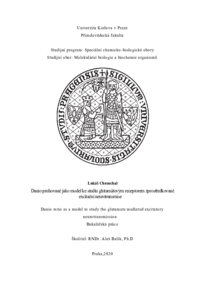Danio pruhované jako model ke studiu glutamátovým receptorem zprostředkované excitační neurotransmise
Zebrafish as a model to study the glutamate receptor mediated excitatory neurotrasmission
bakalářská práce (OBHÁJENO)

Zobrazit/
Trvalý odkaz
http://hdl.handle.net/20.500.11956/119476Identifikátory
SIS: 221166
Kolekce
- Kvalifikační práce [19606]
Autor
Vedoucí práce
Oponent práce
Pangrácová, Marie
Fakulta / součást
Přírodovědecká fakulta
Obor
Molekulární biologie a biochemie organismů
Katedra / ústav / klinika
Katedra fyziologie
Datum obhajoby
8. 7. 2020
Nakladatel
Univerzita Karlova, Přírodovědecká fakultaJazyk
Čeština
Známka
Dobře
Klíčová slova (česky)
excitační přenos, glutamátové receptory, NMDAR, Danio pruhované, behaviorální testy, sociální a explorativní chováníKlíčová slova (anglicky)
excitatory transmission, glutamate receptors, NMDAR, Zebrafish, behavioural tests, social and explorative behaviourGlutamát je nejrozšířenějším excitačním neurotransmiterem mozku obratlovců a je využíván většinu synaptických spojů kortexu. Přenos signálu na těchto neuronech je zprostředkován ionotropními glutamátové receptory, mezi které patří i skupina NMDA receptorů. S rozvojem molekulárně biologických metod a nástupem genomiky došlo k testování genetických změn nalezených u ionotropních glutamátových receptorů, ale i látek modulujících jejich aktivitu. Vzhledem k velkému množství nalezených genetických změn přestaly být pro některé behaviorální studie hlodavci dostatečně robustním systémem. V těchto studiích by mohl modelovým organismus ryba Danio rerio nahradit hlodavce. Využití tohoto modelového organismu by tak mohlo rozšířit poznatky o evoluci a fyziologii glutamátových receptorů. Tato práce si bere za cíl shrnout současné poznatky o využití Dania reria ve výzkumu glutamátových receptorů, a to zejména jeho NMDA typu v centrální nervové soustavě. Dále se zaměřuje na popis specifických behaviorálních testů využívaných k analýze těchto receptorů.
Glutamate is the most prominent excitatory neurotransmitter in the vertebrate brain and is used by most synaptic connections in the cortex. Signal transduction on these neurons is mediated by ionotropic glutamate receptors, including the NMDA receptor family. With the development of molecular biological methods and the advent of genomics, genetic changes found in ionotropic glutamate receptors were tested, as well as substances that modulate their activity. Since a large number of genetic changes found, rodents have ceased to be a sufficiently robust system for some, for example, behavioural studies. In these types of studies, the model organism Danio rerio could replace rodents. The use of this model organism could thus expand knowledge about the evolution and physiology of glutamate receptors. This work aims to summarize the current knowledge about the use of Dania rerio in the research of glutamate receptors, especially NMDA type in the central nervous system. This work also focuses on the description of specific behavioural tests available for the analysis of these receptors.
